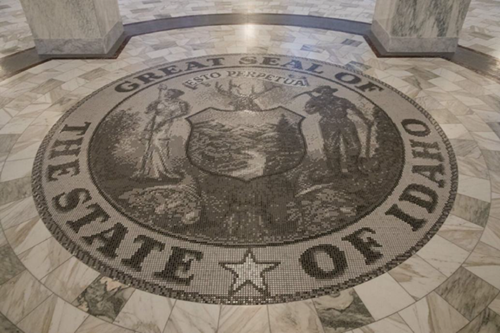Idaho’s State Revenues Beat April’s Forecast, Which Could Mean More Money for Property Tax Cuts
CLARK CORBIN Idaho Capital Sun May 16, 2023

Great seal of the State of Idaho tile work at the Idaho State Capitol building on March 23, 2021
Otto Kitsinger for Idaho Capital Sun
BOISE — Idaho state revenues beat forecasts during the most important tax month of the year, April, which could leave the state with an extra $10.3 million for property tax reductions — as long as revenues meet or beat forecasts during the next two months, the state’s budget chief said.
If revenues hit the forecast for May and June, the state would end the fiscal year June 30 with a balance of $426.6 million, according to the April General Fund Budget Monitor report that the Idaho Legislative Services Office released on Wednesday. Additional budget information is posted on the Legislative Services Office’s website.
That’s $10.3 million more than legislators were expecting when they set the upcoming fiscal year’s budget.
“We generally like what we see,” Alex Adams, administrator of the Idaho Division of Financial Management, said in a telephone interview.
Idaho’s fiscal year calendar runs from July 1 to June 30. That means the 2023 fiscal year ends June 30, and the 2024 fiscal year begins July 1.
Legislators already know what will happen with the money at the end of the 2023 fiscal year.
When they were setting the budget for the upcoming fiscal year, legislators anticipated the state would end the 2023 fiscal year with a balance of $416.4 million. That money will be carried over into the 2024 fiscal year budget that kicks in July 1.
Anything over that amount — up to $50 million — is automatically swept into the homeowner property tax account as part of the Idaho Legislature’s new property tax cut law, House Bill 292. Any surplus between $50 million and $150 million would be split between the school district facilities fund and additional property tax cuts.
Right now, that surplus stands at $10.3 million based on the April revenue report — but, as state budget officials point out, that amount could go up or down depending on what happens with revenues in May and June. The revenue surplus likely won’t exceed $150 million, Adams said. But if they were to exceed that amount, anything above $150 million would carry over into the next fiscal year for future appropriation by the legislature.
Rep. Wendy Horman, the Idaho Falls Republican who serves as the co-chair of the Joint Finance-Appropriations Committee, said the April revenue report is evidence the Idaho Legislature set a responsible budget. The planned ending balance legislators left is still intact and could protect Idahoans if there is a recession or global financial insecurity sparked by the U.S. government defaulting on its national debt, she said.
“We did a lot of right-sizing of the government and we have a plan to start guarding against revenue fluctuations,” Horman said in a telephone interview.
WHY IS THE APRIL REVENUE REPORT SO IMPORTANT IN IDAHO?
There are a couple of reasons why budget analysts and policy wonks watch for the April budget and revenue report each year.
Along with sales tax collections, income taxes are a major driver of the state budget. Tax Day, which is the deadline to submit tax returns, was April 18. That means when they close the books each April, state budget officials have a very good sense of the tax revenue being paid in and the tax refunds being paid out. And the amounts are so large that April has an outsized influence on the rest of the year.
“April makes or breaks the entire budget,” Adams said. “Even if you hit every month’s forecast on the dot prior to that, April still makes or breaks the numbers for the year.”
The April revenue and budget report also gives Idahoans one of the first major looks at where the budget stands following the legislative session, which adjourned April 6.
CONTINUING A TREND FOR IDAHO’S FISCAL HEALTH
Idaho has had back-to-back years of record budget surpluses. There was a $1.4 billion surplus in fiscal year 2022 and an $890 million surplus in fiscal year 2021. Idaho was building toward another potential record surplus early in fiscal year 2023, but legislators and Gov. Brad Little decided to spend down the surplus through tax cuts and a series of one-time infrastructure, roads and water projects.
April’s budget and revenue report shows how the tax rebate legislators passed during the 2022 special session and the 2023 property tax law reduced revenues.
“We were collecting more than we needed for state government,” Horman said. “I think we made some smart moves this session in returning some of those funds through property tax relief and making some really important one-time investments that will provide value to our citizens for generations to come, in the form of parks and recreation, roads and bridges and water, in addition to the expenses we had to maintain in Medicaid and the historic investment we made in K-12 public schools.”
Idaho’s state general fund budget and surplus does not include any of the federal COVID-19 relief dollars Idaho received, Horman said. The federal COVID relief money was kept separate from the state general fund, and legislators and state officials avoided using the federal funds to pay for ongoing state programs or personnel costs because they knew the money would run out, Horman added.
Originally published May 12 on IdahoCapitalSun.com.